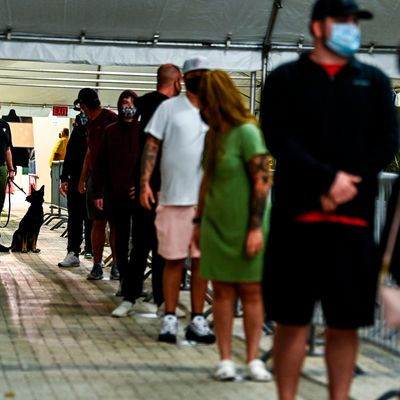
We’re committed to keeping our readers informed.
We’ve removed our paywall from essential coronavirus news stories. Become a subscriber to support our journalists. Subscribe now.
A new variant of the coronavirus believed to spread more easily has forced the United Kingdom into another lockdown and been detected in at least 33 countries, including the United States. Many of the U.S. cases have no known travel history — meaning the strain is spreading throughout communities. The variant, known as B.1.1.7, is not expected to be resistant to the vaccines rolled out in December, though scientists are racing to learn more about the mutation — and where it has already spread. Below is a primer for the public-health and political ramifications of the concerning development.
One study suggests the U.K. strain is spreading rapidly in the U.S.
After the first cases of B.1.1.7. were first identified in the United States in late December, former FDA commissioner Scott Gottlieb warned on January 3 that the new strain could account for the majority of new cases in the U.S. by March.
According to a study in The BMJ published on February 7, the U.S. may already be home to the rapid spread of the U.K. strain. After analyzing around 500,000 COVID-19 tests, researchers determined that the variant is already accounting for 1 percent or 2 percent of new cases — which equates to 1,000 people or more catching the new strain every day. Distressingly, the study suggests that the U.K. variant is doubling its number of confirmed infections every 10 days. The study also confirmed prior predictions that by March, B.1.1.7. will be the dominant strain. To combat the spread of the variant — which has a transmission rate 30 percent to 40 percent higher than that of the dominant COVID strain — virologist and study co-author Kristian Anderson told the New York Times that “what we need to do with the current vaccines is get them into as many people as we can as quickly as possible.”
How is this COVID strain different?
The variation found in the U.K., also known as “VUI – 202012/01” was first identified there in mid-September, according to the World Health Organization. Its mutations have occurred on the genetic material that controls the spike protein, which allows COVID and other similar viruses to penetrate host cells, causing infection.
According to the U.K.’s chief scientific adviser, Patrick Vallance, there are 23 changes in the virus’s genetic material, an unusually large number that appears to be helping it spread more quickly. British officials have now estimated that the strain is as much as 70 percent more transmissible — a number that is based on modeling, but not yet confirmed in lab experiments. A later study, published on December 23, suggested a smaller, but still dangerous number: that the British mutation is 56 percent more contagious. Still, other scientists have expressed skepticism that the mutation necessarily means it is more transmissible, pointing to other potential explanations such as mask-wearing and social distancing.
Though there is no evidence to-date that the strain causes a more intense illness or leads to a higher fatality rate, faster transmission does mean more cases, which can lead to a higher hospitalization rate. In the Atlantic, sociologist Zeynep Tufecki cites the work of Adam Kucharski, a professor at the London School of Hygiene & Tropical Medicine, to explain why an increase in transmissibility is such an alarming development:
Kucharski compares a 50 percent increase in virus lethality to a 50 percent increase in virus transmissibility. Take a virus reproduction rate of about 1.1 and an infection fatality risk of 0.8 percent and imagine 10,000 active infections—a plausible scenario for many European cities, as Kucharski notes. As things stand, with those numbers, we’d expect 129 deaths in a month. If the fatality rate increased by 50 percent, that would lead to 193 deaths. In contrast, a 50 percent increase in transmissibility would lead to a whopping 978 deaths in just one month—assuming, in both scenarios, a six-day infection-generation time.
Are coronavirus variations common?
In general, viruses are prone to picking up small genetic changes as they move through a host population. “Viruses that encode their genome in RNA, such as SARS-CoV-2, HIV and influenza, tend to pick up mutations quickly as they are copied inside their hosts, because enzymes that copy RNA are prone to making errors,” Nature writer Ewen Callaway explains.
Scientists have been tracking minor changes in the COVID-19 genetic code since the beginning of the pandemic, and at least 1,000 variants have been detected so far. But the change to the spike protein found in southeast England represents one of the first coronavirus mutations that have made it more infectious.
As the Wall Street Journal notes, this isn’t the first time that COVID mutations have resulted in a more transmissible strain of the virus:
Scientists in July described a variant that over time displaced an older strain of coronavirus to become the dominant strain in the global pandemic. Experiments showed that variant, known as G614, replicated more quickly, but appeared to be just as susceptible to antibodies that target the earlier strain and wasn’t associated with more severe illness.
Another new strain has been found in California
As the virus rages through southern California, authorities have identified another new strain in a dozen counties, and have connected it to several considerable outbreaks in Santa Clara County. The Los Angeles Times reports that the California Department of Public Health is unsure if “the variant is highly contagious or is just being identified frequently as lab work becomes more sophisticated.” Similar to the U.K. variant, the one found in California appears to feature a mutation on the spike protein. (As The Atlantic’s Sarah Zhang notes, one of the more concerning developments regarding the multiple strains is that they are “mutating in similar ways,” which suggests “that they confer an evolutionary advantage to the virus.”)
How will the U.S. vaccine rollout be impacted by the U.K. strain?
“Our working assumption from all the scientists is that the vaccine response should be adequate for this virus,” Vallance said in a briefing on December 20. Thus, the strain that has shut down southeast England will not cut off the inoculation effort that began on December 8.
U.S. scientists at the Walter Reed Army Institute of Research are still studying the mutation, but Dr. Nelson Michael, director of the institute’s Center for Infectious Diseases Research, agreed that the current vaccines will probably be effective against the new variant. “It stands to reason that this mutation isn’t a threat, but you never know. We still have to be diligent and continue to look,” Michael told CNN.
However, microbiologists that spoke with NBC News shared concerns that the virus could eventually grow to become vaccine-resistant. “Whilst it may not be actually resistant, it may not take so many changes after this for it to get there,” said Ravindra Gupta, a professor of clinical microbiology at the University of Cambridge. Simon Clarke, an associate professor in cellular microbiology at the University of Reading, said the COVID vaccine could eventually become like the flu shot, requiring an updated version every year.
Which countries have banned travel from the United Kingdom?
On December 20, the Netherlands and Belgium were the first nations to suspend air travel from the United Kingdom. They were soon joined by Germany, Ireland, Spain, Italy, and Israel, while the French ban applies to travel over the English Channel as well. The air-travel list eventually grew to include Albania, Argentina, Austria, Bolivia, Bulgaria, Canada, Chile, China, Colombia, Croatia, Cyprus, Denmark, the Dominican Republic, El Salvador, Equitorial Guinea, Estonia, Fiji, Finland, Grenada, Hong Kong, Hungary, India, Indonesia, Iran, Jamaica, Japan, Jordan, Kosovo, Kuwait, Latvia, Lithuania, Malawi, Malta, Mauritius, Moldova, Morocco, Myanmar, Nepal, North Macedonia, Norway, Pakistan, Panama, Paraguay, Peru, the Philippines, Poland, Portugal, Romania, Russia, Seychelles, Singapore, South Korea, Spain, St. Kitts and Nevis, Sudan, Sweden, Switzerland, Tunisia, Turkey, the United States, and Uzbekistan. Many of the bans are temporary, and expired at the end of December or early January.
Until February 15, all travelers flying to the U.K. must also test negative in the time period 72 hours before departure.
Has Biden instituted any new COVID travel restrictions
On January 25, the Biden administration is expected to reimpose a travel ban on most non-citizen visitors who have been to the U.K., Ireland, Brazil, and the 26 countries that make up Europe’s Schengen Area, where travel is permitted across open borders.
The administration will also add South Africa to the list, “because of the concerning variant present,” Dr. Anne Schuchat, the CDC’s principal deputy director, told Reuters.
Are new virus strains active anywhere outside Britain?
Scientists in South Africa have detected a strain that shares one of the mutations of the British coronavirus in up to 90 percent of samples that have been genetically sequenced since mid-November. Evidence suggests that the two variations have arisen separately, according to molecular epidemiologist Emma Hodcroft. Though the variant has not been connected to more severe cases, it is associated with higher viral loads in swab tests, meaning that it is also more transmissible.
South Africa, the hardest-hit nation on the continent, is currently experiencing a second wave driven in part by this more virulent strain and in part by behavior that has undermined public-health measures throughout the pandemic — including a recent party at a beach town on the Indian Ocean, where over 1,000 attendees have already tested positive for COVID-19. At a WHO meeting earlier this month, scientists reported that the new variant made up 80 to 90 percent of infections in South Africa.
Following the announcement of the strain, public-health authorities identified small numbers of cases (ranging from one to nine) in travelers from the U.K. in at least 33 other nations: Australia, Canada, Denmark, France, Germany, Italy, Japan, Lebanon, Singapore, Spain, Sweden, Switzerland, the Netherlands, and the United States.
New COVID strains also appear to be developing elsewhere. On December 24, the head of Africa CDC John Nkengasong said that there is a separate variant developing in Nigeria. A new COVID variant has also been spreading in Brazilian city of Manaus.
This post has been updated.






























